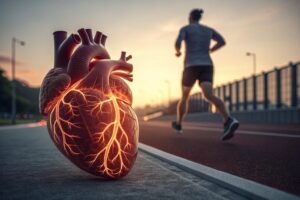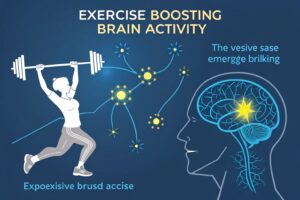Introduction
The Science of Fitness: How Exercise Affects Your Body and Brain is more than a catchy title—it’s a deep dive into the physiological and neurological mechanisms that turn a simple workout into a powerful tool for health, longevity, and mental clarity. When you move, muscles contract, hormones surge, and brain cells fire in patterns that boost mood, sharpen cognition, and protect against disease. This comprehensive guide explains every major system that exercise touches, offering evidence‑based insights you can apply today.
From cardiovascular conditioning to cellular remodeling, the cascade of changes triggered by physical activity is astonishingly complex yet beautifully orchestrated. Whether you’re a beginner curious about why a jog feels rewarding or a seasoned athlete seeking the next level of performance, understanding the science helps you tailor workouts that maximize benefits for both body and brain. Let’s explore the research‑backed pathways that make fitness a cornerstone of optimal health.
How Cardiovascular Exercise Improves Heart Health and Blood Flow

Enhanced Cardiac Output and Stroke Volume
Aerobic activities such as running, cycling, or swimming increase the heart’s demand to pump more blood per minute. This stimulates cardiac hypertrophy—an enlargement of the heart muscle that is healthy, unlike the pathological thickening seen in disease. Over time, the heart’s stroke volume (the amount of blood ejected with each beat) rises, meaning the body receives oxygen‑rich blood more efficiently with each contraction.
Vascular Remodeling and Endothelial Function
Exercise triggers shear stress on the inner lining of blood vessels, prompting endothelial cells to release nitric oxide. This gas relaxes smooth muscle, dilating arteries and improving overall vascular compliance. The result is lower peripheral resistance, reduced blood pressure, and a decreased risk of atherosclerotic plaque formation. Studies show that regular cardio can reverse early signs of arterial stiffening.
Metabolic Implications of Aerobic Training
Beyond the heart itself, sustained cardio enhances mitochondrial density in skeletal muscle, which boosts oxidative capacity and insulin sensitivity. Better glucose utilization reduces the likelihood of type‑2 diabetes and supports weight management—both critical for long‑term cardiovascular health. The synergy between a stronger heart and metabolically active muscles creates a virtuous cycle of health.
Strength Training: Building Muscle, Bone, and Metabolic Power
Muscle Protein Synthesis and Hypertrophy
Resistance workouts activate the mTOR pathway, a molecular cascade that drives muscle protein synthesis (MPS). When combined with adequate protein intake, this leads to hypertrophy—an increase in muscle cross‑sectional area. Larger muscles not only improve strength but also raise resting metabolic rate because each pound of muscle burns more calories at rest than fat.
Bone Density and Mechanical Loading
High‑impact or weight‑bearing exercises generate mechanical strain on bone tissue, stimulating osteoblast activity. This remodeling process enhances bone mineral density (BMD), lowering the risk of osteoporosis and fractures as you age. Research indicates that even moderate resistance training (2–3 sessions per week) can preserve BMD in post‑menopausal women.
Hormonal Cascade: Testosterone, Growth Hormone, and IGF‑1
Strength training provokes an acute rise in anabolic hormones—testosterone, growth hormone (GH), and insulin‑like growth factor‑1 (IGF‑1). These hormones synergistically promote tissue repair, increase protein synthesis, and improve neuromuscular coordination. The long‑term hormonal adaptations contribute to better body composition and enhanced recovery capacity.
Neurobiology of Exercise: How Workouts Boost Brain Function

Neurotrophic Factors and Synaptic Plasticity
Physical activity elevates brain‑derived neurotrophic factor (BDNF), a protein that supports neuron survival, growth, and synaptic plasticity. Higher BDNF levels are linked with improved learning, memory consolidation, and mood regulation. Both aerobic and resistance training can raise BDNF, though cardio tends to produce the most robust spikes.
Stress Hormone Regulation and Mental Health
Exercise reduces chronic cortisol exposure while increasing endorphin and serotonin production. This hormonal shift dampens the stress response, leading to lower anxiety and depression scores. Meta‑analyses of randomized controlled trials reveal that regular moderate‑intensity exercise is as effective as psychotherapy for mild to moderate depressive disorders.
Structural Brain Changes
Longitudinal MRI studies show that individuals who engage in consistent aerobic exercise develop larger hippocampal volumes—a brain region essential for memory and spatial navigation. Similarly, resistance training has been associated with increased cortical thickness in prefrontal areas responsible for executive function and decision‑making. These structural adaptations help preserve cognitive abilities well into later life.
Metabolic Mastery: Exercise’s Role in Fat Burning, Insulin Sensitivity, and Longevity
Fat Oxidation and Energy Substrate Shifts
During prolonged moderate‑intensity exercise, the body transitions from glycogen to fatty acid oxidation, sparing glucose for vital organs. This metabolic flexibility improves overall energy efficiency and assists in weight loss. High‑intensity interval training (HIIT) further amplifies post‑exercise oxygen consumption (EPOC), prolonging calorie burn for up to 48 hours after the session.
Improved Insulin Sensitivity
Muscle contractions activate GLUT4 transporters independently of insulin, facilitating glucose uptake into cells. Repeated bouts of activity improve insulin signalling pathways, decreasing fasting insulin levels and enhancing glycated hemoglobin (HbA1c) profiles. For individuals with pre‑diabetes, consistent exercise can delay or even reverse disease progression.
Cellular Longevity Pathways: Autophagy and Sirtuins
Exercise initiates autophagy, a cellular “recycling” process that removes damaged mitochondria and proteins, thereby reducing oxidative stress. Additionally, physical activity upregulates sirtuin proteins (especially SIRT1), which are linked to DNA repair, mitochondrial biogenesis, and extended lifespan in animal models. These molecular benefits suggest that regular movement may contribute to healthy aging.
Practical Guidelines: Designing a Science‑Backed Workout Routine
Frequency, Intensity, Time, and Type (F.I.T.T.) Framework
The F.I.T.T. principle remains the gold standard for program design. Aim for at least 150 minutes of moderate‑intensity cardio or 75 minutes of vigorous cardio per week, supplemented by 2–3 strength sessions targeting major muscle groups. Adjust intensity based on perceived exertion (RPE) or heart rate zones to ensure you’re stimulating the desired physiological pathways without overtraining.
Periodization for Continuous Progress
Implement macro‑cycles (3–6 months) broken into meso‑cycles (4–6 weeks) and micro‑cycles (weekly). Cycle between phases of hypertrophy, strength, power, and recovery. Periodization prevents plateaus, reduces injury risk, and aligns with the body’s adaptive timelines—allowing you to reap both muscular and neurological gains.
Recovery, Nutrition, and Lifestyle Integration
Recovery is as crucial as the workout itself. Prioritize 7‑9 hours of sleep, incorporate active recovery (light walking, yoga), and consume a balanced diet rich in lean protein, complex carbohydrates, healthy fats, and micronutrients (especially magnesium, vitamin D, and omega‑3s). Hydration, stress management, and regular health screenings round out a holistic approach that maximizes the benefits described in The Science of Fitness: How Exercise Affects Your Body and Brain.
Understanding the intricate science behind fitness empowers you to make informed choices that optimize both physical health and cognitive performance. From heart‑pumping cardio to bone‑strengthening resistance work, every movement triggers a cascade of biochemical and structural changes that protect against disease, enhance mood, and sharpen the mind. By applying the evidence‑based strategies outlined above, you can craft a personalized routine that not only meets but exceeds your health goals—proving that the true power of exercise lies at the intersection of body and brain.


